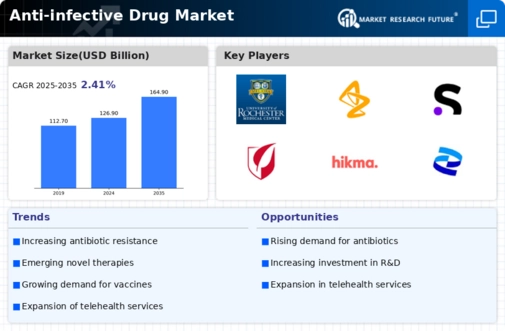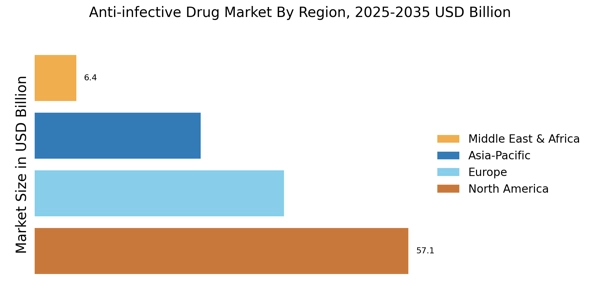Rising Healthcare Expenditure
The rise in healthcare expenditure is a significant factor propelling the Anti-infective Drug Market. As countries allocate more resources to healthcare, there is an increased focus on addressing infectious diseases through effective treatment options. Higher healthcare spending allows for better access to anti-infective drugs, including antibiotics and antivirals, which are essential in managing infections. Data indicates that healthcare expenditure is projected to continue its upward trajectory, driven by factors such as aging populations and the increasing burden of chronic diseases. This trend suggests that the Anti-infective Drug Market will likely expand, supported by enhanced funding for research, development, and distribution of anti-infective therapies.
Regulatory Support for Drug Approvals
Regulatory support for the approval of new anti-infective drugs is a crucial driver of the Anti-infective Drug Market. Regulatory agencies are increasingly recognizing the urgent need for new treatments to combat rising antibiotic resistance and emerging infectious diseases. Initiatives such as expedited review processes and incentives for antibiotic development are being implemented to encourage pharmaceutical companies to invest in this area. For instance, the FDA has introduced programs aimed at facilitating the development of novel anti-infective therapies. This supportive regulatory environment is likely to accelerate the introduction of innovative drugs into the market, thereby enhancing the overall growth of the Anti-infective Drug Market.
Growing Awareness of Preventive Healthcare
The increasing awareness of preventive healthcare is shaping the Anti-infective Drug Market. As individuals become more informed about health risks associated with infectious diseases, there is a growing emphasis on vaccination and prophylactic treatments. Public health campaigns and educational initiatives are encouraging populations to adopt preventive measures, thereby driving demand for anti-infective drugs. For example, vaccination programs targeting diseases such as influenza and hepatitis have gained traction, leading to higher vaccination rates. This trend not only reduces the incidence of infections but also stimulates the market for anti-infective drugs used in conjunction with preventive strategies. Consequently, the Anti-infective Drug Market is likely to benefit from this shift towards proactive health management.
Increasing Incidence of Infectious Diseases
The rising incidence of infectious diseases is a primary driver of the Anti-infective Drug Market. Factors such as urbanization, population growth, and climate change contribute to the spread of pathogens. According to recent data, the prevalence of infectious diseases has surged, with millions affected annually. This trend necessitates the development and distribution of anti-infective drugs to combat these diseases effectively. The demand for innovative therapies and vaccines is expected to escalate, prompting pharmaceutical companies to invest heavily in research and development. As a result, the Anti-infective Drug Market is likely to experience substantial growth, driven by the urgent need for effective treatments and preventive measures against infectious agents.
Advancements in Drug Development Technologies
Technological advancements in drug development are significantly influencing the Anti-infective Drug Market. Innovations such as high-throughput screening, bioinformatics, and artificial intelligence are streamlining the drug discovery process. These technologies enable researchers to identify potential anti-infective compounds more efficiently, reducing the time and cost associated with bringing new drugs to market. For instance, the integration of machine learning algorithms in drug design has shown promise in predicting the efficacy of new anti-infective agents. As a result, the market is witnessing a surge in novel drug candidates, which could potentially address the challenges posed by antibiotic resistance. This dynamic environment suggests that the Anti-infective Drug Market will continue to evolve, driven by the need for rapid and effective solutions to combat infectious diseases.


















Leave a Comment